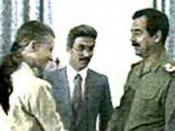Evil tyrants are nothing new to the region of Babylon, present-day Iraq. One of the most vicious in history was Nebuchadnezzar (sixth century BCE), the Babylonian king who built the most powerful nation in the world by ruthlessly attacking and annexing neighboring countries.
In Jewish tradition, the Tenth of Tevet (January 4, 2004) commemorates the day when Nebuchadnezzar laid siege to Jerusalem. The Babylonians eventually destroyed the First Temple, slaughtered 100,000 Jews, rounded up the rest and sent them into exile.
Whenever Nebuchadnezzar made a conquest, he used the stolen wealth to build monuments to his own glory. It was in his capital city that Nebuchadnezzar built the legendary Hanging Gardens of Babylon. In testimony to his grandeur, each brick was inscribed with Nebuchadnezzar's name.
And so it is in our time. Saddam Hussein pronounced himself as the reincarnation of Nebuchadnezzar, and dreamed of restoring the Babylonian empire to its former size and glory.
North of the ancient city of Ur, on the Euphrates River, lies the biblical city of Babylon. Years ago, Saddam commissioned archaeologists to restore the city and its Hanging Gardens. Like Nebuchadnezzar 2,500 years earlier, each new brick was inscribed -- this time with Saddam's name.
During the course of the dig, archaeologists uncovered a plaque on the ancient city gate proclaiming Nebuchadnezzar's greatness. Saddam ordered stonemasons to place another plaque on the opposite side of the gate -- glorifying the greatness of Saddam Hussein.
With his megalomaniacal vision in place, Saddam embarked on a campaign of terror and conquest, first in Iran, then in Kuwait. Ultimately, he dreamed of recapturing Jerusalem.
In 1981, threatened by Saddam's burgeoning nuclear capability, the State of Israel sent a squadron of seven jets to destroy the Iraqi nuclear reactor at Osirak. Saddam had named the reactor "Tammuz."...


![[Abraham Lincoln, Congressman-elect from Illinois. Three-quarter length portrait, seated, facing front] (LOC)](https://s.writework.com/uploads/7/77419/abraham-lincoln-congressman-elect-illinois-three-quarter-le-thumb.jpg)
Amber
I find it very interesting the comparison made between Nebuchadnezzar and Saddam Hussein. Although, i don't seem to come across any form of references. Do you have any form evidence backing up your statement?
0 out of 0 people found this comment useful.